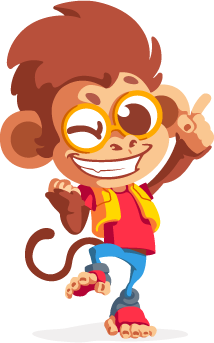Escola Games | Jogos Educativos
https://www.escolagames.com.br
Teacher's support sheet

The largest and the smallest of the jungle
We are in the jungles to find the largest and the smallest animals. The giraffe, elephant, and jaguar are some animals we will meet on our way, but don't worry! They are our friends and will play with us!

Teacher's tips
Level of Education: Elementary School - Preschool Subject: Mathematics Theme: Quantities and measurements Age: 05 to 07 years old
Students can play individually or in groups. As they play, make sure students use the concepts of largest and smallest, as it is an opportunity for them to relate to the vocabulary and use them appropriately. Note that there is a dashed line following the command. It is also important to show children the size of each animal. Explore it during the game, having the students analyze and reflect on the measure. [FIM-DICA]
Learner outcomes
- To identify the concepts of "larger than" and "smaller than";
- To compare quantities and measurements;
- To use different strategies to identify numbers in situations involving counting and measurements;
- To solve problem situations involving relationships between numbers, such as: being greater than, being smaller than;
- To relate measures, making simple estimates;
- To compare two images of different sizes;
- To improve the ability of visual discrimination.
Teachers’ goals
- To work playfully with the mathematical concepts "greater than" and "smaller than";
- To reinforce content discussed during the classes
- To present an activity that encourages students to connect the related content to mathematics;
- To develop children's ability to observe and visualize;
- To offer situations so that students use the concepts outside the classroom.
Suggestions of approaches for the teacher
These mathematical concepts must be in students' lives through plays, games, and other playful activities. Here are some proposals to be part of the stages of your Pedagogical Project:
(Approach 1) Using diverse materials, ask students to separate them into "small" and "large" groups.
(Approach 2) Using play dough, tell students to make objects of different sizes: a small die and a large die, a small ball and a large ball, etc.
(Approach 3) Take a measuring tape and ruler to the classroom and measure different objects.
(Approach 4) Use buckets with students to show them the capacity of larger and smaller containers. You can play in the sand and use the smaller bucket to put a little water and the larger one to fill with sand.
(Approach 5) Use students' toys to classify: put the smaller toys in one container and the larger ones in another.
(Approach 6) Ask students to bring stuffed animals to school. Then, divide them into smaller and larger groups.
(Approach 7) Organize a queue in ascending order and analyze the height of the students who stayed in the 1st and last place.
(Approach 8) Work with geometric shapes made on colored paper in different sizes. Tell students to analyze them, share their ideas with their classmates, and then separate them by color and size.
(Approach 9) Separate students in ascending and descending order. Then, highlight other characteristics to separate them into categories, such as the tallest and shortest girl or boy.
(Approach 10) Tell students to write the ascending and descending order of the numbers from 1 to 20.
(Approach 11) Use paint to paint students' hands to print them on cardboard. Then, ask them to organize them into the ascending order. You can expose the project to a mural. Students can also print their feet.
(Approach 12) Assign a survey to students' parents:
- Who is the tallest person in the house?
- How tall were you born?
- Who is the shortest person in your family?
- What is the largest object in the house? And the smallest?
(Approach 13) Divide a sheet of paper into two. On the board, glue different pictures of different objects. Ask students to classify them into ‘smaller than’ and ‘larger than.’ Tell them to take into consideration the real size of the images. Present them the greater than and less than symbols and tell students to use them when separating the images.
(Approach 14) Numbers dictation: Say two numbers aloud and students should write which one is greater than the other.
(Approach 15) Separate objects in the classroom of different sizes (chair, pencil, rubber, chalk, etc.) to compare.
More about the content
Top 9 math strategies for engaging lessons Keep reading to uncover all of our top math strategies for keeping your students excited about math.
- Explicit instruction You can’t always jump straight into the fun. Explicit instruction still provides the best foundation for the activities to come. Set up your lesson for the day on the whiteboard, along with materials to demonstrate the coming activities. Make sure to also focus on any new vocabulary and concepts. Tip: don't stay here for too long. Once the lesson is introduced, move on to the next fun strategy for the day!
- Conceptual understanding Helping your students understand the concept behind the lesson is crucial, but not always easy. Even your highest performing students may only be following a pattern to solve problems, without grasping the “why.” Visual aids and math manipulatives are some of your best tools to increase conceptual understanding. Math is not a two-dimensional subject. Even the best drawing of a cone isn’t going to provide the same experience as holding one. Find ways to let your students examine math from all sides. Math manipulatives don’t need to be anything fancy. Basic wooden blocks, magnets, molding clay, and other toys can create great hands-on lessons. No need to invest in expensive or hard-to-find materials. Math word problems are also a great time to break out a full-fledged demo. Hot Wheels cars can demonstrate velocity and acceleration. A tape measure is an interactive way to teach area and volume. These materials give your students a chance to bring math off the page and into real life.
- Using concepts in Math vocabulary
There’s more than one way to say something. And the more ways you can describe a mathematical concept, the better. Subtraction can also be described as taking away or removing. Memorizing multiplication facts is useful, but seeing these numbers used to calculate area gives them new meaning.
Some math words are going to be unfamiliar. So to help students get comfortable with these concepts, demonstrate and label math ideas throughout your classroom. Understanding comes more easily when students are surrounded by new ideas.
For example, create a division corner in your station rotations, with blocks to demonstrate the concept of one number going into another. Use baskets and labels to have students separate the blocks into each part of the division problem: dividend, divisor, quotient, and remainder.
Give students time to explore, and teach them big ideas with both academic and everyday terms. Demystify math and watch their confidence build! - Cooperative learning strategies When students work together, it benefits everyone. More advanced students can lead, helping them solidify their knowledge. And they may have just the right words to describe an idea to others who are struggling. It is rare in real-life situations for big problems to be solved alone. Cooperative learning allows students to view a problem from various angles. This can lead to more flexible, out-of-the-box thinking. After reviewing a word problem together as a class, ask small student groups to create their own problems. What is something they care about that they can solve with these skills? Involve them as much as possible in both planning and solving. Encourage each student to think about what they bring to the group. There’s no better preparation for the future than learning to work as a team.
- Meaningful and frequent homework When it comes to homework, it pays to think outside of textbooks and worksheets. Repetition is important, but how can you keep it fun? Create more meaningful homework by including games in your curriculum plans. Encourage board game play or encourage families to play quiz-style games at home to improve critical thinking, problem-solving, and basic math skills. Sometimes you need homework that doesn’t put extra work on the parents. The end of the day is already full for many families. To encourage practice and give parents a break, assign game-based options like Prodigy Math Game for homework. With Prodigy, students can enjoy a fun, video game experience that helps them stay excited and motivated to keep learning. They’ll practice math skills, while their parents have time to fix dinner. Plus, you’ll get progress reports that can help you plan future instruction. Win-win-win!
- Puzzle pieces math instruction Some kids excel at math. But others pull back and may rarely participate. That lack of confidence is hard to break through. How can you get your reluctant students to join in? Try giving each student a piece of the puzzle. When you’re presenting your class with a problem, this creates necessary collaboration to get to the solution. Each student is given a piece of information needed to solve the problem. A number, a unit of measurement, or direction — break your problem into as many pieces as possible. If you have a large class, break down three or more problems at a time. The first task: find the other students who are working on your problem (try color-coding or using symbols to distinguish each problem’s parts). Then watch the learning happen as everyone plays their own important role.
- Verbalize math problems There’s little time to slow down in the classroom. Instruction has to move fast to keep up with the expected standards. And students feel that, too. When possible, try to set aside some time to ask about your students’ math struggles. Make sure they know that they can come to you when they get stuck. Keep the conversation open to their questions as much as possible. One great way to encourage questions is to address common troubles students have encountered in the past. Where have your past classes struggled? Point these out during your explicit instruction, and let your students know this is a tricky area. It’s always encouraging to know you’re not alone in finding something difficult. This also leaves the door open for questions, leading to more discovery and greater understanding.
- Reflection time Providing time to reflect gives the brain a chance to process the work completed. This can be done after both group and individual activities. Group Reflection After a collaborative activity, save some time for the group to discuss the project. Encourage them to ask:
- What worked?
- What didn’t work?
- Did I learn a new approach?
- What could we have done differently?
- Did someone share something I had never thought of before? These questions encourage critical thinking. They also show the value of working together with others to solve a problem. Everyone has different ways of approaching a problem, and they’re all valuable. Individual Reflection One way to make math more approachable is to show how often math is used. Journaling math encounters can be a great way for students to see that math is all around. Ask them to add a little bit to their journal every day, even just a line or two. Where did they encounter math outside of class? Or what have they learned in class that has helped them at home? Math skills easily transfer outside of the classroom. Help them see how much they have grown, both in terms of academics and social-emotional learning.
- Making Math facts fun As a teacher, you know math is anything but boring. But transferring that passion to your students is a tricky task. So how can you make learning math facts fun? Play games! Math games are great classroom activities. Here are a few examples:
- Design and play a board game.
- Build structures and judge durability.
- Divide into groups for a quiz or game show.
- Get kids moving and measure the speed or distance jumped. Even repetitive tasks can be fun with the right tools. That’s why engaging games are a great way to help students build essential math skills. https://www.prodigygame.com/main-en/blog/math-strategies/
